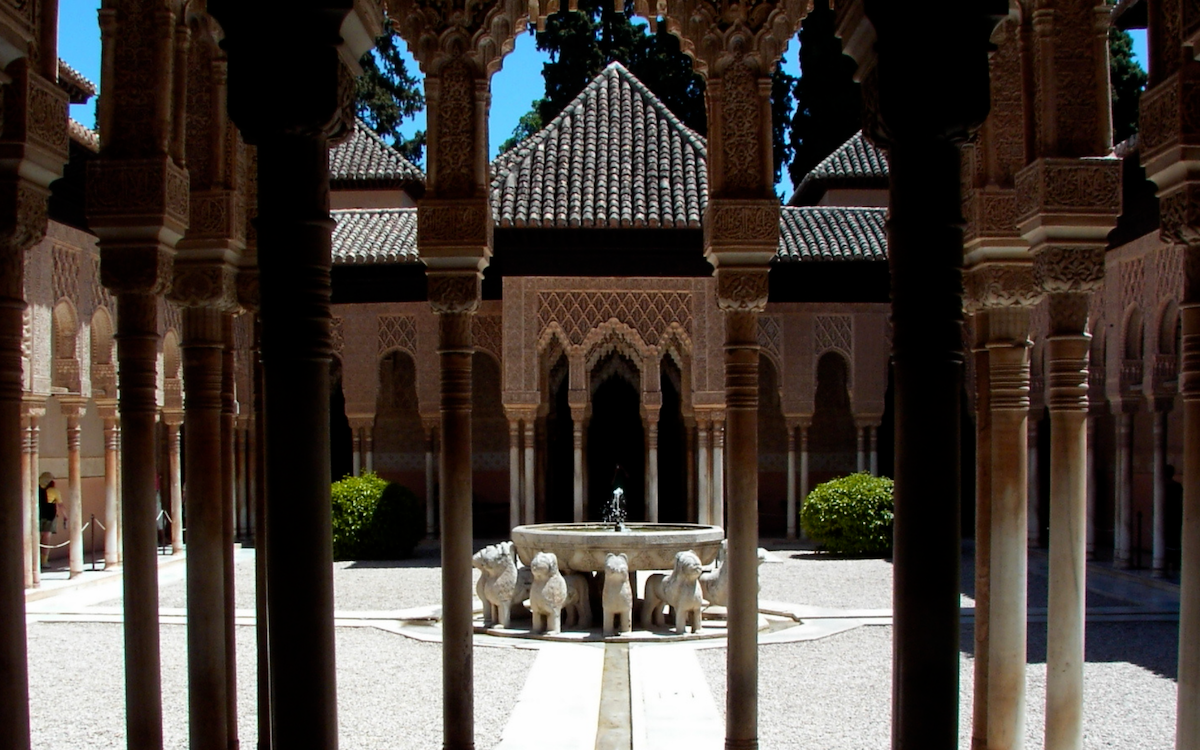
Sufi Spaces
Rahal Eks

Image: "Alhambra patio de leones" by Rahal Eks.
You may wonder what the sacred spaces where Sufis gather to do their exercises are? Depending on the language in use, we get a variety of names.
In Arabic, the word is zaouiya, also spelled zawiya. In Turkish, it is tekkia and also dergah, while in Persian dargah and khaniqah are used. In English, we would speak of a Sufi lodge or Sufi center.
A Sufi center may or may not include a shrine with a Sufi tomb. It may or may not have an attached mosque and madrassa, a Qur’an school. It may also serve as a kind of hostel for visiting dervishes and or house Sufi residents.
Some Sufi centers also serve as kitchens to feed the poor and the visitors, or they may have hospitals attached like, for example, some Khaniqahs of the Nimatullahi Sufi Order in certain African countries.
They may serve as places of visit to people with physical and psychosomatic and mental illnesses who might spend time there to get healed by the baraka, such as, for example, the zaouiya and shrine in Tamegroute, in southern Morocco on the edge of the Sahara.
A Sufi lodge could also be in any house or apartment anywhere in the world. However, it will be energized for this purpose and decorated with specific Sufi symbols, calligraphies, kilims, carpets, and the integration of color and, when possible natural materials, as well as plants and running water or a fountain.
Specifically, constructed Sufi centers are often octagonal in shape when this is possible. Or they may follow the design of Moorish architecture with a central garden courtyard and a water fountain. Or, like in the old days in Turkey, they were sometimes made out of wood.
Whatever the material and design may be, the function of the Sufi center is the same. It serves foremost as a meeting place for Sufi seekers to gather and do their exercises, meditate and perform dhikr and sama’ or listen to a teaching talk of the Sufi guide and teacher in charge.
Some Sufi centers are open day and night, every day of the week, with ongoing activities. Others meet exclusively on Thursday evenings and perhaps on another additional day, which could vary according to the group or Sufi Order.
However, the Thursday evening Sufi meetings are rather universal, done by most Sufis anywhere in the world. It is known as the night of Mushkil Gusha, the Problem Dissolver, and his tale is retold on Thursday nights in many tongues all over the planet.
There are also Sufis who gather in Sufi mosques. These are like any mosque, only run by Sufis and allowing for Sufi activities such as dhikr circles and sama’ or also called hadra in parts of North Africa. Other Sufis might meet in a Café, or in their homes, or regularly rent a space where any events can take place.
The format and the type of dhikr and exercises vary according to Sufi Order and group, depending again on time, place, people, and culture.
But in essence, it can be said that the Sufi evening consists of a social part, usually sharing a meal, and a formal part doing exercises, listening to music and meditating, or having the teacher give a lecture. This could happen in any order; some groups follow a clear ritual. Others keep things fresh and alive and improvise according to the needs of the moment.
Regardless of whether the Sufi center is an elaborate architectural marvel with tiles and in an octagonal shape in certain proportions or just a rented modern apartment where the teacher happens to live, it is always seen as a special and sacred place energized with the baraka, and healing energies and the members of the Sufi group usually contribute to maintaining the place and are involved in its running.
Some Sufi centers may be very visible and easy to find. But there are also Sufi centers that are only known to insiders, meaning initiated members and invited guests.
There might be different reasons for being more or less visible. In some countries, the Sufi Tradition is not very well seen and might even be forced to function in a more discreet way, if not to say in secrecy.
In other parts, the Sufi Tradition may be highly esteemed and getting official approval and even help in order to flourish.
Currently, the climate is most favorable for the Sufi Tradition to bloom and develop in the Western World. This, of course, includes Europe and the Americas, where Sufi centers have been built or are in construction in various locations.
This doesn’t mean that the Sufi Tradition died in the East; au contraire, it continues to exist. Alas, even if facing restrictions and difficulties. But as the Sufi saying goes: “This too shall pass!”
Sufism has always existed and will continue to do so, as long as there are people willing to walk the Path of the Heart. Ya Haqq!
Saludos! May love and blessings be with you! Ishq bashad wa Baraka bashad!
Want to read more from "Sufism 101"? Here are the links, just click on the section you want to read: Sufi Origins, Sufi Beliefs, Sufi Practices, Sufi Spaces, and Sufi Personalities.
ولا غالب إلا الله